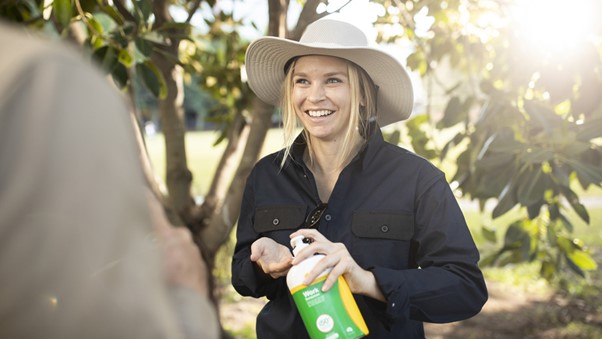Working Safely Outdoors in WA
If you regularly work outdoors, protecting your skin from the sun is recommended all year round, regardless of UV level – even on cool and overcast days.1
This is because you’re exposed to UV radiation daily, for long periods – and it is this year-round accumulation of sun exposure that increases your risk of skin cancer. Each year in Australia, it is estimated that 200 melanomas and 34,000 non-melanomas are caused by exposure to solar ultra violet radiation.5
If you work outdoors and are exposed to ultra violet light, you are at greater risk of developing skin cancer. You should protect your skin from sun damage every day by following five simple sun smart steps.
Sun Smart Steps
- Slip on sun protective clothing.
- Slop on SPF 30 (or higher) broad-spectrum, water-resistant sunscreen
- Slap on a broad brimmed hat
- Seek shade
- Slide on your sunnies.2

It’s important not to rely on sunscreen alone, as the only form of sun protection. Sunscreens should not be used to extend the duration of sun exposure as this will likely to lead to increased risk of excessive UV radiation exposure. It is advisable to apply sunscreen every day to exposed parts of the skin.5
Did you know that a sunscreen with SPF 15 filters 94% of UVB, and SPF 30 filters 97%, with only marginal percent increases thereafter as the SPF increases above 30.4
How much sunscreen is enough?
Approximately 35ml has been recommended as a helpful indicator of adequate full body coverage. In anticipation of possible under-application, it may be better to use of sunscreen with an SPF of 30 or greater in order to maximize the effective SPF.
In general, sunscreen should be applied generously and evenly 20 minutes prior to initial sun exposure, reapplied initially 20 minutes later to ensure complete coverage (this helps cover any areas missed during the first application) and then reapplied every 2–3 hours while outside.4
In reality if you’re an outdoor worker it’s not always easy to avoid the sun, but being sun smart should be part of your everyday routine. Wear protective clothing, apply sunscreen to exposed areas of skin (don’t forget your ears and lips), wear a broad brimmed hat, seek shade whenever possible and make sure you wear your sunnies.4

- Australian Cancer Network. (2008). Clinical practice guide: Basal cell carcinoma, squamous cell carcinoma (and related lesions): a guide to clinical management in Australia.
- Clinical practice guidelines for keratinocyte cancer. (2019). https://wiki.cancer.org.au/australia/Guidelines:Keratinocyte_carcinoma#_ga=2.157950074.1589455274.1678679318-308822593.1678679317
- Kolokythas, A. (2014). Lip cancer. https://doi.org/10.1007/978-3-642-38180-5
- Rigel, D. S., Friedman, R., Robinson, J. K., Ross, M. I., Cockerell, C. J., Lim, H., Stockfleth, E., & Kirkwood, J. M. (2011). Cancer of the skin (2nd ed.). Elsevier Health Sciences.
- Workplace Skin Cancer Statistics & Issues. (2022). https://wiki.cancer.org.au/skincancerstats/Settings:_Workplace
